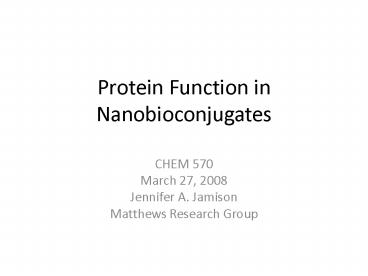Protein Function in Nanobioconjugates - PowerPoint PPT Presentation
1 / 56
Title:
Protein Function in Nanobioconjugates
Description:
A biomolecule (protein, DNA, RNA, etc.) attached to a ... Hainfeld, J.F.; Powell, R.D. Journal of Histology & Cytochemistry 2000, Vol. 48(4): 471-480 ... – PowerPoint PPT presentation
Number of Views:54
Avg rating:3.0/5.0
Title: Protein Function in Nanobioconjugates
1
Protein Function in Nanobioconjugates
- CHEM 570
- March 27, 2008
- Jennifer A. Jamison
- Matthews Research Group
2
Outline
- Nanobioconjugates
- Definition
- Motivation Why do we care?
- My Research
- Objective
- Introduction to Proteins
- Model Sytem
- Overview of Gel Electrophoresis
- Stability and Stoichiometry
- Application Epitope-Mapping
- Conclusions
3
What are Nanobioconjugates?
- A biomolecule (protein, DNA, RNA, etc.) attached
to a nanomaterial
Electrostatically
Covalently
S
S
S
-
-
S
S
-
S
-
S
S
4
What are Nanobioconjugates?
- A biomolecule (protein, DNA, RNA, etc.) attached
to a nanomaterial
Electrostatically
Covalently
S
S
S
-
-
S
S
-
S
-
S
S
5
What are Nanobioconjugates?
- A biomolecule (protein, DNA, RNA, etc.) attached
to a nanomaterial
Electrostatically
Covalently
S
S
S
-
-
S
S
-
S
-
S
S
6
Why Study Nanobioconjugates?
- Hybrid materials Hybrid properties
- Exploit nano properties in the bio applications
- Fluorescence, magnetism, etc.
- Use bio properties to affect nano synthesis
- Self-assembly, nano-patterning
7
Applications
- Drug Delivery
- Electron Microscopy Tags
- Sensing/Detection
- MRI Contrast Agents
- Consumer Products
- Etc.
8
Applications
- Drug Delivery
- Electron Microscopy Tags
- Sensing/Detection
- MRI Contrast Agents
- Consumer Products
- Etc.
These applications could change the way we
practice medicine!
9
Example Application Breast Cancer Detection
Breast carcinoma cells, with green QDots With R.
Drezek (Rice University)
10
Objective
To understand and manipulate protein-nanoparticle
interactions
Electrostatic
Non- Specific
What governs these types of interactions?
Targeted
Covalent
11
Objective
To understand and manipulate protein-nanoparticle
interactions
Electrostatic
Non- Specific
What governs these types of interactions?
Targeted
Covalent
12
Objective
To understand and manipulate protein-nanoparticle
interactions
Electrostatic
Non- Specific
What governs these types of interactions?
Targeted
Covalent
13
Quick Intro to Proteins.
Amino Acid
www.wikipedia.org
14
Quick Intro to Proteins.
Amino Acid
Chains of amino acids make up proteins.
)8
8(
www.wikipedia.org
15
Quick Intro to Proteins.
Amino Acid
Chains of amino acids make up proteins.
Amino Acid 2
Amino Acid 1
)8
8(
www.wikipedia.org
16
Due to non-covalent interactions, proteins fold
into complex structures..
17
Representations of 3D Protein Structures
Ribbon Linguini
Ball and Stick
Space-filling
18
My Research
19
My Model Nanobioconjugate System
15 nm
4.4 nm
Myoglobin
Immunoglobin G
Gold Nanocrystal
MW 1,000 kDa Isoelectric point 5.5
14 nm
Kent, M.S. Yim, H. Sasaki, D.Y. Langmuir
2004,20, 2819-2829
Hainfeld, J.F. Powell, R.D. Journal of
Histology Cytochemistry 2000, Vol. 48(4)
471-480
http//www.umass.edu/microbio/rasmol/igg_w.gif
20
Synthesis of Aqueous Gold Nanoparticles
- 10-15 size distribution
- Particles gt 10 nm in diameter
- Solution of HAuCl4H2O
Dispersion of Gold Nanoparticles
AuCl2-
AuCl2-
AuCl2-
Au
AuCl2-
AuCl2-
AuCl2-
AuCl2-
AuCl2-
21
Synthesis of Nanobioconjugates
or
Gold Nanoparticles
Unstable ?
Stable ?
But, how do we know if the proteins are actually
attached? How do we determine the number of
proteins on the surface of the nanoparticles?
22
Flocculation Assay
Add 1 sodium chloride to nanobioconjugates with
varying protein concentrations.
No protein / No NaCl
No protein NaCl
Protein NaCl
when the particles are completely covered by the
protein, they will not change colors
23
Flocculation Assay
Increasing Protein Concentration
24
Quantify Flocculation Assays
Ultra-Violet/Visible Spectroscopy
IgG (uM)
myoglobin (uM)
control
control
25
We have determined stability and quantified the
number of proteins.
- Now, what about protein function?
26
Gel Electrophoresis
- Separates proteins based on size
First, proteins are unfolded and charged.
Sodium Dodecyl Sulfate (SDS)
27
Gel Electrophoresis
28
Gel Electrophoresis
29
Gel Electrophoresis
30
Gel Electrophoresis
31
Gel Electrophoresis
32
Gel Electrophoresis
33
Gel Electrophoresis
34
Gel Electrophoresis
35
Gel Electrophoresis
36
Gel Electrophoresis
37
Gel Electrophoresis
-
Apply a Voltage
38
Gel Electrophoresis
-
Apply a Voltage
39
Gel Electrophoresis
-
Large Proteins
Small Proteins
Apply a Voltage
40
Electrophoresis Confirmation of IgG Orientation
IgG bands either missing or too light to detect!
myoglobin
IgG
IgG first
Myo first
41
Nanobioconjugates for Epitope-Mapping
42
Objective
To understand and manipulate protein-nanoparticle
interactions
Electrostatic
Non- Specific
What governs these types of interactions?
Targeted
Covalent
43
Objective
To understand and manipulate protein-nanoparticle
interactions
Electrostatic
Non- Specific
What governs these types of interactions?
Targeted
Covalent
44
Definitions
Antibody
Antigen
45
Definitions
Paratope
Epitope
Antibody
Antigen
46
Definitions
Paratope
Epitope
Antibody
Antigen
We actually dont know the epitope of Myoglobin!
47
Epitope-Mapping
- Studying the interactions of antibodies with
specific regions of protein antigens - Very expensive and time-consuming!
48
Epitope-Mapping
- Studying the interactions of antibodies with
specific regions of protein antigens - Very expensive and time-consuming!
- Why should anyone care?
- Development of new vaccines diagnostics
49
Can we use nanobioconjugates to determine the
relative position of the epitope?
?
50
Can we use nanobioconjugates to determine the
relative position of the epitope?
?
51
Can we use nanobioconjugates to determine the
relative position of the epitope?
?
52
Can we use nanobioconjugates to determine the
relative position of the epitope?
?
One mutants interaction with the gold
nanoparticles should occlude the epitope region
and either prevent IgG from binding or decrease
its binding affinity in comparision to the other
mutants.
53
Myoglobin Mutants
54
Myoglobin Mutants
55
Myoglobin Mutants
- K63C mutant does not interact as well with
IgG (near epitope?)
56
Summary Conclusions
- Nanobioconjugates
- Nanomaterial Biomolecule
- Have both nano and bio properties
- Stability can be quantified
- Stoichiometry can be evaluated
- Epitope-Mapping
- Nanobioconjugates provide an easier and cheaper
way of determining epitopes .































